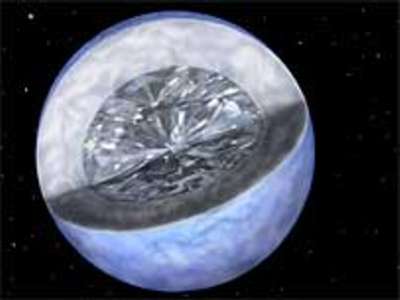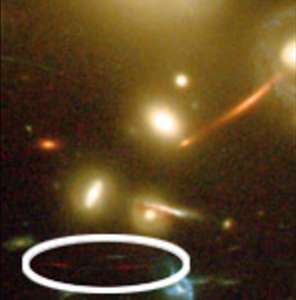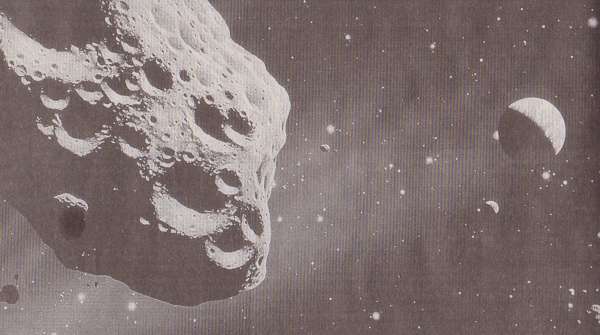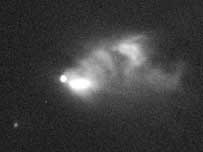
MARCH 2004
| Diamond star thrills
astronomers By Dr David Whitehouse BBC News Online  Twinkling in the sky is a diamond star of 10 billion trillion trillion carats, astronomers have discovered. The cosmic diamond is a chunk of crystallised carbon, 1,500 km across, some 50 light-years from the Earth in the constellation Centaurus. It's the compressed heart of an old star that was once bright like our Sun but has since faded and shrunk. Astronomers have decided to call the star "Lucy," after the Beatles song, "Lucy in the Sky with Diamonds." Lucy in the sky "You would need a jeweller's loupe the size of the Sun to grade this diamond!" says astronomer Travis Metcalfe of the Harvard-Smithsonian Center for Astrophysics, who led the team of researchers that discovered it. The diamond star completely outclasses the largest diamond on Earth, the 530-carat Star of Africa which resides in the Crown Jewels of England. The Star of Africa was cut from the largest diamond ever found on Earth, a measly 3,100-carat gem. The huge cosmic diamond - technically known as BPM 37093 - is actually a crystallised white dwarf. A white dwarf is the hot core of a star, left over after the star uses up its nuclear fuel and dies. It is made mostly of carbon. For more than four decades, astronomers have thought that the interiors of white dwarfs crystallised, but obtaining direct evidence became possible only recently. The white dwarf is not only radiant but also rings like a gigantic gong, undergoing constant pulsations. "By measuring those pulsations, we were able to study the hidden interior of the white dwarf, just like seismograph measurements of earthquakes allow geologists to study the interior of the Earth. We figured out that the carbon interior of this white dwarf has solidified to form the galaxy's largest diamond," says Metcalfe. Astronomers expect our Sun will become a white dwarf when it dies 5 billion years from now. Some two billion years after that, the Sun's ember core will crystallise as well, leaving a giant diamond in the centre of our Solar System. "Our Sun will become a diamond that truly is forever," says Metcalfe.
The farthest object in the Universe yet detected has been seen by scientists using the Hubble and Keck telescopes. It is so distant its light must have set out when the Universe was just 750m years old to reach the Earth now. Details of the discovery were revealed by a team of astrophysicists from the California Institute of Technology. They said the work underlined again the remarkable capabilities of Hubble and called on Nasa to reverse its decision to stop servicing the telescope. The US space agency has confirmed it will not send another shuttle to upgrade the space telescope, which probably means Hubble has no more than three years of full observations ahead of it. "We need Hubble... we could not have made this discovery without it," said Caltech's Richard Ellis, who was explaining his institute's latest work at the annual meeting of the American Association for the Advancement of Science here in Washington State. "One of the instruments that would be placed on the telescope is a new infrared camera which would be perfect for the work we want to do. "Many of us hope the decision to abandon further visits to Hubble will be examined very carefully because the scientific potential is very great." Cosmic history The new object was first seen in a series of observations of a cluster of galaxies known as Abell 2218, conducted with Hubble's Advanced Camera for Surveys, installed on its last servicing mission. The object is not in the cluster but situated a long way behind it. Abell 2218 was simply used as a "gravitational lens" - a massive foreground object that can bend and magnify the light of objects much further away. Gravitational lensing is a remarkable astronomical trick, first predicted by Einstein, that allows scientists to probe regions of the Universe that are estimated to be 13bn light-years away - to look back in time to when some of the very first stars were shining. The Hubble images were analysed to work out the new object's redshift, which measures the degree to which its light is being stretched by the expansion of the Universe. The greater the redshift, the more distant the object and the earlier it is being seen in cosmic history. Switch on The Hubble data suggested a redshift of 6.6, but follow-up observations with the 10-metre Keck telescopes on Hawaii indicated the new object probably has a redshift closer to 7.0 - a record. "The new object is a small and compact system of stars," said Professor Ellis. "It's about 2,000 light-years across; our own galaxy by comparison is about 60,000 light-years across. "It is forming stars prodigiously and is a very energetic source, so it may be an example of an object from that early time [just after the "Dark Ages"] that is the first of its kind to form in the Universe." The term "Dark Ages" was coined by the English Astronomer Royal, Sir Martin Rees, to signify the period in cosmic history when hydrogen atoms first formed but stars had not yet had the opportunity to condense and ignite. Nobody is quite clear how long this phase lasted, and the detailed study of the cosmic sources that brought this period to an end is a major goal of modern cosmology. The latest discovery has been
written up for a forthcoming paper in the
Astrophysical Journal. The lead author is Caltech
astronomer Jean-Paul Kneib. heavenly
body An amateur astronomer in the US has detected the emergence of a young star from the cocoon of gas and dust in which it was born. Such an event has only rarely been recorded by astronomers. 'From my back
yard' The new object was first spotted on 23 January by amateur astronomer Jay McNeil from his observatory at Paducah in Kentucky. "The entire discovery was quite serendipitous in nature," he told BBC News Online. While looking at star formation regions in the constellation of Orion, he noticed a star not present in previous sky surveys. "I have spent countless hours seeking out the darkest of skies and peering into the largest of telescopes at distant galaxies, so who would have known that I would take an image of a famous object with a small telescope from my back yard and find a sun-like star being born." The new object had
appeared alongside the well-known gas cloud known
as Messier 78. The new object was just a faint smudge. I contacted Brian Skiff at the Lowell Observatory who also realised it was new," says McNeil. Suspecting that it was a young star that had just broken out of its birth cloud of gas and dust, McNeil then contacted star formation expert Bo Reipurth. Reipurth arranged for follow-up observations to be carried out using the University of Hawaii 2.2 metre telescope, and then using the giant 8-metre Gemini telescope, also in Hawaii. McNeil was amazed at the train of events following his discovery, "The idea that this thing, first seen on my 3-inch telescope, which one can easily hold using one hand, would be observed, within 48 hours, by a telescope of 342 tons was absolutely staggering." Stellar landscape Following those observations Reipurth told BBC News Online: "The young star was embedded in its placental nebula. Now it has brightened, and like a lighthouse it is casting its light across the landscape of dust and gas around it." "We know of many small nebula like this scattered throughout the sky but it is very rare to see an event like this. We know very little about these objects and do not know what to expect next." An urgent appeal has gone out to astronomers to monitor the object which is now known as McNeil's nebula. "We will lose it in about six weeks when Orion goes behind the Sun. We will then have to wait until the autumn for it to be observable again. I expect it will have changed by then," says Reipurth. "I'm thrilled to have found it and to be a part of such a great effort," says McNeil. ..................................................................*..................................................................... |


